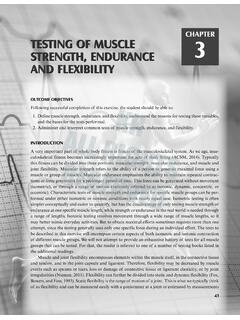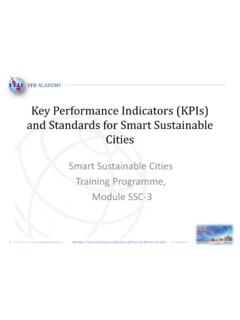Transcription of The Growth and Development of College Students
1 8 CHAPTER133 This chapter considers the biological, psychological, and social Development of traditional-aged College Students those between the ages of 18 and 24. The focus is on normal Development during these years. Normal means the average behavioral changes, or those that the majority of College Students experience. If you think of a normal distribution curve, the term includes those responses that fall within one standard deviation above or below the mean for any particular person moves through Development at his or her own pace. Maturation is infl uenced by individual differences that may accelerate or retard the process of Development . Social factors, biological factors, and experience all play roles in the pace at which one DevelopmentDuring the years of young adulthood, men and women biologically are becoming adults.
2 Women begin puberty somewhere between the ages of 8 and 13, and men start puberty approximately two years later between the ages of 10 and 15. Puberty The Growth and Development of College Students Andresr, 2010. Under license from Shutterstock, 1332/16/10 12:18 PM2/16/10 12:18 PMFrom "The Resident Assistant," 7th ed. By Gregory Blimling 2010 Kendall Hunt Publishing Co. P A R T 2 The Growth and Development of College Studentsis the period when a person becomes physically mature enough to reproduce. It involves developing secondary sexual characteristics associated with gender and with hormonal changes in the , women reach their full height at about the age of 17. Men lag behind and do not reach their full height until about the age of 21. Men and women grow differently during this period of adolescence. Men s shoulders grow wider, their chest cavity expands, and their legs and forearms grow longer.
3 Women grow wider in the pelvic area, ostensibly to enhance their ability to bear children, and their breasts, legs, arms, and torso Growth PatternsGrowth is not necessarily proportional throughout the entire adolescent period. Different portions of the body grow at different rates; therefore, some portions of the body may reach maturity faster than others. Typically the extremities, head, hands, and feet reach maturity prior to the legs, arms, and trunk of the body. This constantly fl uctuating size leads to a decrease in motor skill coordination because individuals are learning to adapt to the changing size of their body. The description of the awkward adolescent is a refl ection of this uneven Growth toward generations have seen a trend (known as the secular trend) toward increasing size and earlier sexual maturity.
4 Zastrow and Kirst-Ashman noted that sons are likely to be as much as one inch taller and 10 pounds heavier than their fathers, and daughters will be between one-half to one full inch taller than their mothers and approximately two pounds heavier. Menstruation is occurring in women of the current generation about 10 months earlier than it did for their mothers. The secular trend is worldwide. The reason for this trend appears to be related to better nutrition, better standards of living, and possibly the dominance of genes for tallness and rapid maturation. For the time being, this trend for increased size seems to have stabilized in the American College , men and women approach their physical prime, reaching their full muscular Development generally between the ages of 25 and 30. Top physical speed, dexterity, and overall strength generally continue to increase until about the age of 30, when a gradual decline begins.
5 Eyesight and hearing continue to improve and are best at about the age of For the most part, College Students are in good health and generally have a high energy issues that interfere with good health are heavy drinking, drug use, and stress. The major causes of death among College Students are auto accidents and suicides. In a high percentage of cases, alcohol use is involved with both causes of 1341/7/10 6:51 PM1/7/10 6:51 PMFrom "The Resident Assistant," 7th ed. By Gregory Blimling 2010 Kendall Hunt Publishing Co. CHAPTER 8 The Growth and Development of College Students 135 Psychological Adaptation to Physical DevelopmentIn 1981 Blyth, Bulcroft, and Simmons conducted a study in Wisconsin on early and late maturation.
6 They found that boys who matured early had a higher self-concept, were generally less satisfi ed with their overall physical Development , tended to be more popular with girls, and participated in more school activities during high school. The same study found that early maturing girls were also less satisfi ed with their bodies than late maturers, were more often in dating relationships with boys, and had more behavior problems during middle short-term implications of early and late maturation appear to affect self-concept and early identity formation. Early maturers generally had greater self-esteem, and some evidence indicates that early maturers may have been pushed prematurely into decisions about These differences appear to be short lived. By the age of 30 there are generally no signifi cant differences in physical size, educational attainment, marital status, socioeconomic status, or the number of children per family unit.
7 One benefi t to late maturing may be that late maturers are forced to deal with ambiguity in adolescence and to develop an increased tolerance for uncertainty. As a result, they tend to be somewhat more fl Development during the College YearsOne of the most dynamic periods of psychological Growth occurs during the College years. In this period, young adults begin to integrate their identity, enhance their intellectual Development , and internalize a personal set of beliefs and values. As people mature, they change. Sanford defi ned change as a system that is altered from a previous state. 5 Two forms of change take place as a person matures. The fi rst is Growth , which Sanford described as an expansion of the personality by addition of parts or expansion of existing parts. The second is Development , defi ned as the process of organizing with increasing complexity.
8 Both forms Growth and Development occur simultaneously throughout a person s is driven by two forces: epigenesis and social role Epigenesis is an internal evolutionary clock that biologically and psychologically pushes us toward maturity. Puberty is one example of this clock or internal force that drives the individual forward. Social role expectations are behaviors that are culturally associated with a person s age and gender . As we grow older, society expects us to be increasingly independent, less impulsive, and more in control of our lives. When a person s behavior confl icts with the social role expectations at a particular age, the person experiences a developmental crisis. These crises are good. They force people to evaluate their current behavior and pattern of thinking and 1351/7/10 6:51 PM1/7/10 6:51 PMFrom "The Resident Assistant," 7th ed.
9 By Gregory Blimling 2010 Kendall Hunt Publishing Co. A R T 2 The Growth and Development of College Studentsto adjust them to meet new social role expectations. All this simply means that society has come to expect more mature behavior from people as they grow older, and that society defi nes how people are expected to behave at different periods in their lives. Epigenesis complements this follows a logical sequence of stages. At each stage, people work to resolve the same or similar issues. These issues are referred to as developmental tasks, and they have a logic to their progression. For example, when children are very young, parents establish and enforce a bedtime. As a child grows older, this bedtime may be moved to a later time of the evening, but is still enforced.
10 By the time the child reaches high school, typically parents no longer enforce any bedtime and leave this decision to the child. However, parents of high school Students usually establish a curfew for when their children must return home. As the child grows older, the curfew is generally withdrawn, and the time in which a single person may be expected back in the parents home is left to the discretion of the young adult, with the understanding that some basic courtesies are respected in the family culture in which psychosocial Development occurs infl uences the individual. Because cultures vary widely, different social infl uences may accelerate or retard different forms of Development . Environment and social role expectations combine to infl uence Development . For example, it is unusual to fi nd a young man at the age of 17 living in a midwestern town who does not have a driver s license.

















